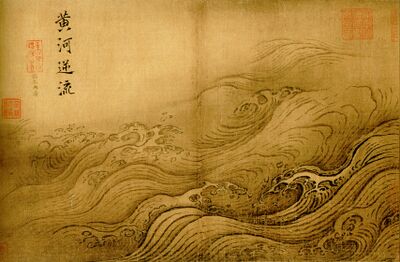Huaxia (Gruppa4)
Huaxia 華夏 | |
|---|---|
| Motto: Towards the Golden Emperor | |
| Largest city | New Zion |
| Recognised regional languages | Cantonese English |
| Demonym(s) | Huanxi Huaxian (informal) |
| Government | Council of Government |
| Legislature | Grand Huaxia Congress |
| Formal Region of Gruppa4 | |
• First Grand Huaxia Congress | June 11, 1932 |
| Population | |
• 2020 estimate | 181,000,000 |
• 2016 census | 179,254,497 |
| GDP (nominal) | 2020 estimate |
• Total | 11.76 Trillion Satarii |
• Per capita | 65,000 Satarii |
| HDI (2020) | .75 high |
| Currency | Satarius (unofficial) |
| Driving side | left |
Huaxia is an informal grouping of diverse polities united through a common heritage of being descended from a single long-spanning civilization that previously convered all of modern-day Huaxia and beyond. Subsuquently, Huaxians view themselves as inhabitants the inner sphere of "Heaven" in the world, with Huaxia at the cultural and spiritual center. Huaxia today is an extremely diverse region, with countless languages, ethnic groups, and cultures within its borders.
Political power within Huaxia is held by the "Banner Kings" who have absolute dominion within their distinctive territory and over their own militas. These Kings delegate power to various nobles underneath them, who in turn manage various ministries and other affairs. Huaxian localities similarly have so called district magistrates to enforce laws created by the Banner Kings. The Banner Kings, nobles, and other lords and officials convene anually in the Grand Huaxia Congresses to coordinate policy. Additionally, meetings are attended by various special interest groups and secret societies, who have achieved a level of quasi-legitimacy in Huaxian affairs. These secret societies control large parts of the economy and are responsible for much Huaxian political thought, even stretching into Proletsvet and Império where they hold influence. Many of them ideologically hold visions of uniting Huaxia once again, something shared by the various Banner Kings. Each seeks to vie for supremacy over the other and attain complete control over Huaxia, establishing a second great Golden Empire.
Today, Huaxia as a whole does not exist as a unified political body, with no common government, leader, or ideology. It cooperates with its neighbors on regional and international matters without the existence of a codifed political body to enforce any decisions on constituent member states. As a result, Huaxian politics are mired in short-term alliances, political maneuvering, and off-record deals. Additionally, Huaxian relations with Proletsvet and Império are even more complex, with each Huaxian polity having independant relations with non-Huaxian polities, each of which is different in subtle or overt ways, which results in exceptionally convoluted alliances during armed conflict.
Etymology
The word Huaxia is a combination of the words hua (華), meaning 'beauty', and xia (夏) meaning 'grandness'. Together they form the expression "beautiful grandeur", in reference to the land of the first Golden Empire, the pre-cursor to modern day Huaxia.
History
The history of the region of Huaxia is ancient and incomplete in parts, with many cultural artifacts, documents, and other important items lost during the Grey Period. What survives indicates that Huaxia has been continuously inhabited for at least 4000 years, with the oldest known archeological evidence being clay pots unearthed dating back to ~2500 BC. It has gone through many great upheavals in that time, from the age of the warring kingdoms, to the First Golden Empire, the fall and following grey period, the establishment of the First Grand Huaxia Congress, and the current troubles of the modern era.
Pre-history
The first cultures known to inhabit Huaxia were farming and fishing communities, largerly centered around the Golden River, in modern day HMOG. The surviving cultural artifacts found in the area dated to those times indicate that these people were comparatively civilized relative to their neighbors, or they represented themselves as such, referring to the people outside the river region as barbarous. Nothing else is known about these barbarians, other than they were antagonists to the way of life of the early Huaxians.
The Golden Empire
Grey Period
First Grand Huaxia Congress
Modern Era
Geography
Politics
While not being a unified political body like other regions in the world, Huaxian polities cooperate with one another on regional and interregional matters. In addition to direct diplomatic missions between polities, all Huaxian polities meet yearly for the Grand Huaxia Congress in the city of New Zion, HMOG. Banner Lords from each polity appoint 1-3 councillors to the congress, who serve their position until they are replaced. Individuals chosen to be councillors usually are experts in politics, economics, or other fields of importance, and serve on the congressional council as advisors to the Banner Lords. While their judgement is intended to be unbiased, impartial council, there is historical precedent of councillors being appointed to further the political goals of a single polity, instead of representing the interests of all Huaxians.
Lists of Polities
| Name | Capital | Population (2020 estimate) | Area (km²) | Head of State | Head of Government | Government type |
|---|---|---|---|---|---|---|
| New Zion | Pop. TBD | Area TBD | HoS | HoG | Theocratic Deleuzian-Fascist Aristocracy | |
| Omhaya | 14,880,000 | Area TBD | Warlord Sovereign | Unitary Pirate Syndicacy | ||
| Huangjin lu | Capital | Pop. TBD | Area TBD | HoS | HoG | Taoist Anti-Modernist Monarchy |


